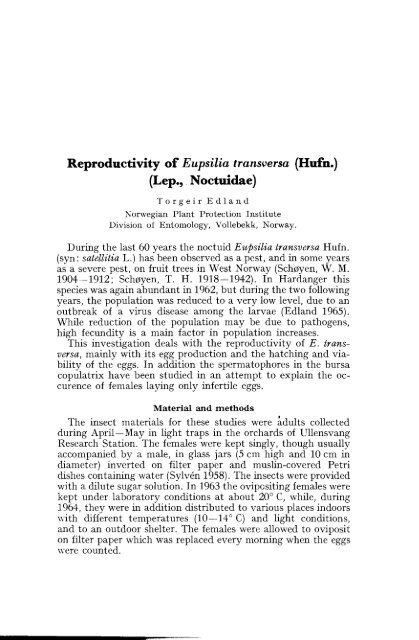Full-text - Norsk entomologisk forening
Full-text - Norsk entomologisk forening
Full-text - Norsk entomologisk forening
You also want an ePaper? Increase the reach of your titles
YUMPU automatically turns print PDFs into web optimized ePapers that Google loves.
Reproductivity of Eupsilia transversa (Hufn.)(Lep., Noctuidae)Torgeir EdlandSorwegian Plant Protection InstituteDivision of Entomology, Vollebekk, Norway.During the last 60 years the noctuid Eupsilia tramversa Hufn.(syn : satellitia L.) has been observed as a pest, and in some yearsas a severe pest, on fruit trees in West Norway (Scheryen, W. M.1904-1912; Scheryen, T. H. 1918-1942). In Hardanger thisspecies was again abundant in 1962, but during the two followingyears, the population was reduced to a very low level, due to anoutbreak of a virus disease among the larvae (Edland 1965).While reduction of the population may be due to pathogens,high fecundity is a main factor in population increases.This investigation deals with the reproductivity of E. tramversa,mainly with its egg production and the hatching and viabilityof the eggs. In addtion the spermatophores in the bursacopulatrix have been studied in an attempt to explain the occurenceof females laying only infertile eggs.Material and methodsThe insect materials for these studies were &dults collectedduring April-May in light traps in the orchards of UllensvangResearch Station. The females were kept singly, though usuallyaccompanied by a male, in glass jars (5 cm high and 10 cm indiameter) inverted on filter paper and muslin-covered Petridishes containing water (Sylvkn 1958). The insects were providedwith a dilute sugar solution. In 1963 the ovipositing females werekept under laboratory conditions at about 20" C, while, during1964, they were in addition distributed to various places indoors\vith different temperatures (10-14" C) and light conditions,and to an outdoor shelter. The females were allowed to ovipositon filter paper which was replaced every morning when the eggswere counted.
















